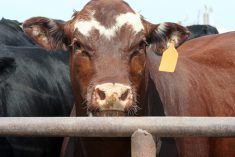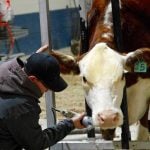Western Canadian feeder cattle prices were extremely volatile this past week. In eastern Saskatchewan and Manitoba, the weaker Canadian dollar had a noticeable effect on demand, with the market trading steady to slightly higher in certain cases.
Alberta values, however, were definitely softer as cattle prices came under pressure causing feeding margins to narrow. Buyers were once again focused on quality and potential for efficient gains, negating other features such as weaning or vaccination. Every year, more cow-calf operators are transitioning to later calving dates — and feedlot operators were surprised by the number of fresh bawlers coming on the market in the range of 500 to 600 pounds.
Read Also

Canadian trade data delayed by U.S. government shutdown
Canadian international trade data for September will be delayed indefinitely due to the ongoing partial shutdown of the United States government, Statistics Canada said Friday, Oct. 24.
There was very strong buying interest in this category: silver steers just under 575 lbs. sold for $308 at an auction north of Calgary. Buyers were more cautious on cattle above 600 lbs., probably due to the uncertainty in margins in during the fall period. Larger-frame red Angus-based semi-weaned steers averaging 625 lbs. were quoted at $270 in the Lethbridge area. Replacement cattle weighing 800-plus lbs. were down $3 to $6 from seven days earlier, because June live cattle futures appear to be dropping like a power window.
All eyes were once again on the U.S. feeder market, where prices were $8-$12 lower for a second week in a row. Breakeven pen closeout prices in the U.S. southern Plains are way above current market values for the summer, setting a negative tone in the feeder complex.
The U.S. Department of Agriculture’s cattle on feed report showed Jan. 1 inventories up one per cent over year-ago levels, while December feedlot marketings were down five per cent. U.S. second-quarter beef production will come in larger than earlier anticipated. Interesting to note: McDonald’s experienced a 1.7 per cent decline in same-store sales in the U.S during the fourth quarter. This may be due to “higher quality eating habits,” but the market took this as a note of caution on slowing beef demand.
– Jerry Klassen is a commodity market analyst in Winnipeg and maintains an interest in the family feedlot in southern Alberta. He writes an in-depth biweekly commentary, Canadian Feedlot and Cattle Market Analysis, for feedlot operators in Canada. He can be reached by email at [email protected] for questions or comments.

















